Professor Liu Changkun's team from the College of Chemistry and Environmental Engineering at Shenzhen University has published a series of research papers in the field of membrane materials and membrane separation in international journals such as Chemical Engineering Journal and Journal of Membrane Science.
Forward osmosis membrane separation technology is widely used in fields such as seawater desalination and wastewater treatment due to its high water recovery rate and relatively low membrane fouling tendency. The research paper titled "A novel cockscomb-like substrate-supported TFN-FO membrane with a dispersed bovine serum albumin (BSA)/gold nanoparticles (GNPs) interface layer exhibiting high performance" is authored by Master's student Fuqing Ma as the first author, with Associate Professor Changkun Liu as the corresponding author. The first author affiliation and corresponding affiliation are both from Shenzhen University. This paper was published in the international journal Desalination, which has a recent impact factor of 11.211 and is listed as Tier 1 of the Journal Citation Reports (JCR) categorized by the Chinese Academy of Sciences.
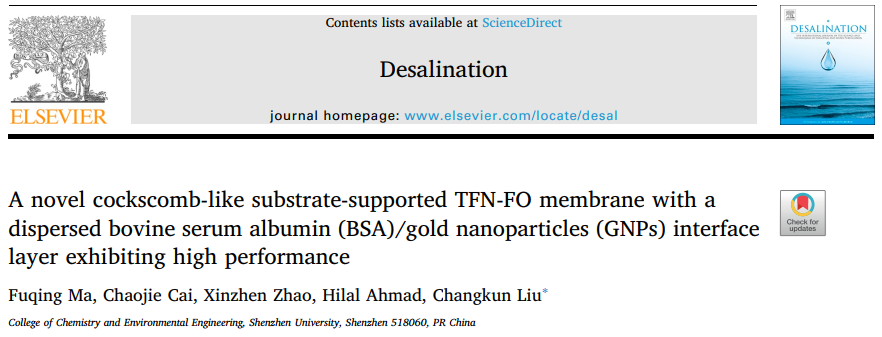
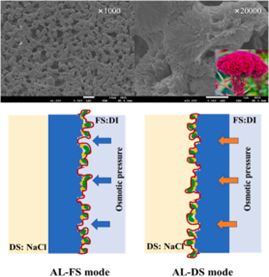
The mentioned paper reports on the development of a novel thin film nanocomposite (TFN) forward osmosis (FO) membrane by loading bovine serum albumin (BSA) and gold nanoparticles (GNPs) onto a cockscomb-like nylon support membrane. The BSA/GNPs provide additional nanoscale water channels, increasing the roughness of the polyamide (PA) layer and enlarging the effective surface area, thus enhancing the permeability performance of the TFN-FO membrane. The experimental results demonstrate that the water flux (Jw) of the BSA/GNPs-modified membrane reaches as high as 55.2 ± 5.4 L/(m2·h), while Js/Jw decreases to 0.034 g/L, reflecting its high selectivity. This paper successfully constructs a high-performance TFN-FO membrane and provides a novel method for the preparation of such membranes. The membrane's surface morphology, roughness, surface charge, and forward osmosis performance were comprehensively characterized and studied, contributing to the development of high-performance TFN-FO membranes.
Full-text link: https://doi.org/10.1016/j.desal.2020.114732
Nanofiltration membranes are widely used for the selective separation of harmful dyes and salts in saline textile wastewater due to their high water permeability and high retention rate. The research paper titled "Construction of an electroneutral zinc incorporated polymer network nanocomposite membrane with enhanced selectivity for salt/dye separation" is authored by Research Associate Faizal Soyekwo as the first author, with Associate Professor Changkun Liu as the corresponding author. The first author affiliation and corresponding affiliation are both from Shenzhen University. This paper was published in the international journal Chemical Engineering Journal, which has a recent impact factor of 16.744 and is listed as Tier 1 of the Journal Citation Reports (JCR) categorized by the Chinese Academy of Sciences.
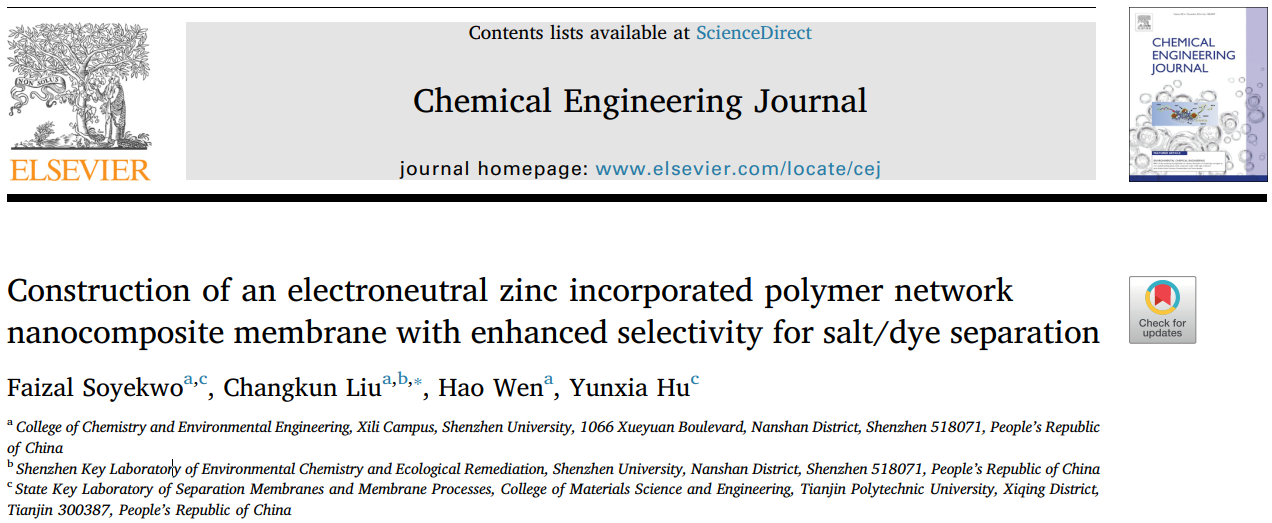
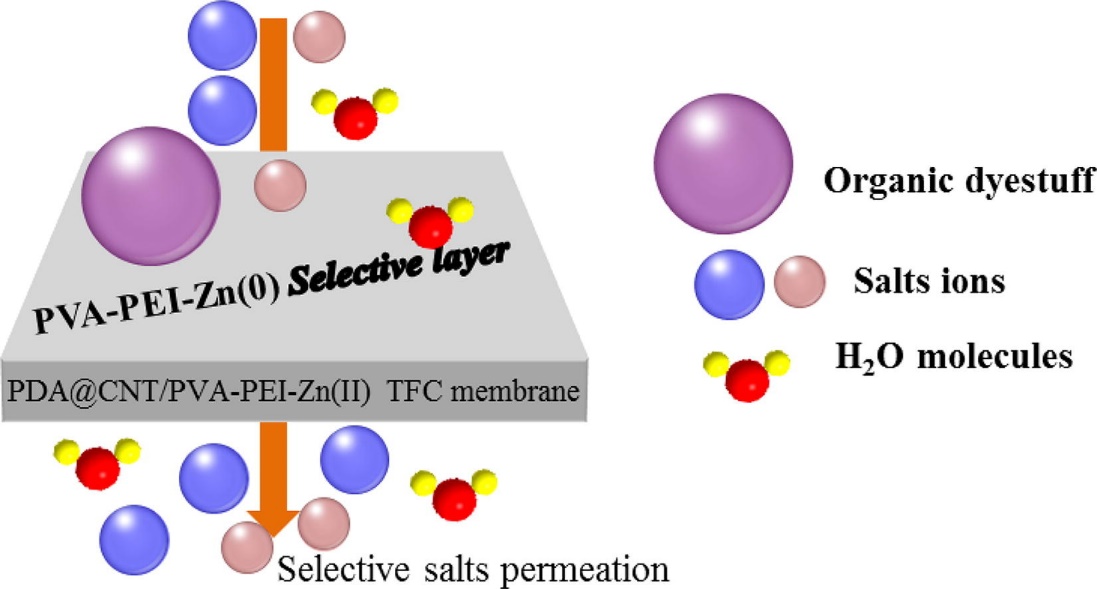
Electroneutral nanofiltration (NF) membranes play a crucial role in treating high salinity textile wastewater. However, preparing electroneutral thin-film composite (TFC) membranes over a wide pH range is challenging. In this study, an electroneutral NF-TFC membrane was prepared using zinc-ion crosslinked polyvinyl alcohol (PVA)-polyethyleneimine (PEI) to construct a polyamide (PA) layer. The coordination bonding between Zn2+ and the amino groups (-NH2) in PEI promoted ionization, resulting in a hydrophilic and near-electroneutral membrane in the pH range of 5.0-8.6. The results demonstrated that the membrane exhibited excellent retention (>99.7%) for bromothymol blue (BTB), congo red (CR), and direct yellow (DY) dye molecules. Moreover, it showed low salt rejections for NaCl (3.35%) and Na2SO4 (11.57%). Additionally, the water flux reached 84 L m−2 h−1 under a pressure of 5 bar. Long-term salt/dye mixed solution tests revealed that salts did not affect the membrane's separation efficiency for dyes, resulting in a high NaCl/CR selectivity (932). The prepared electroneutral NF membrane showcased potential for treating saline textile wastewater, offering a novel and efficient strategy for purifying saline textile wastewater.
Full-text link: https://doi.org/10.1016/j.cej.2019.122560
Organic solvent nanofiltration (OSN) membranes have emerged as an efficient alternative for solvent-solute separation due to their low energy consumption, high separation efficiency, and simple operation. The research paper titled "Crosslinked copolystyrenes based membranes bearing alkylcarboxylated and alkylsulfonated side chains for organic solvent nanofiltration" is authored by Research Associate Faizal Soyekwo as the first author, with Associate Professor Changkun Liu as the corresponding author. The first author affiliation and corresponding affiliation are both from Shenzhen University. This paper was published in the international journal Separation and Purification Technology, which has a recent impact factor of 9.136 and is listed as Tier 1 of the Journal Citation Reports (JCR) categorized by the Chinese Academy of Sciences.
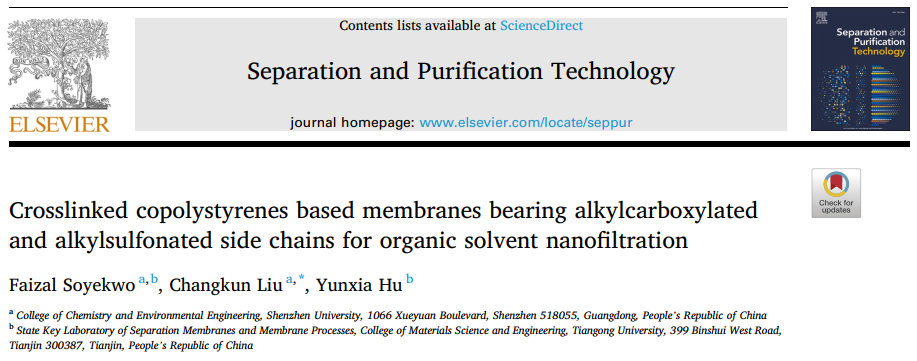
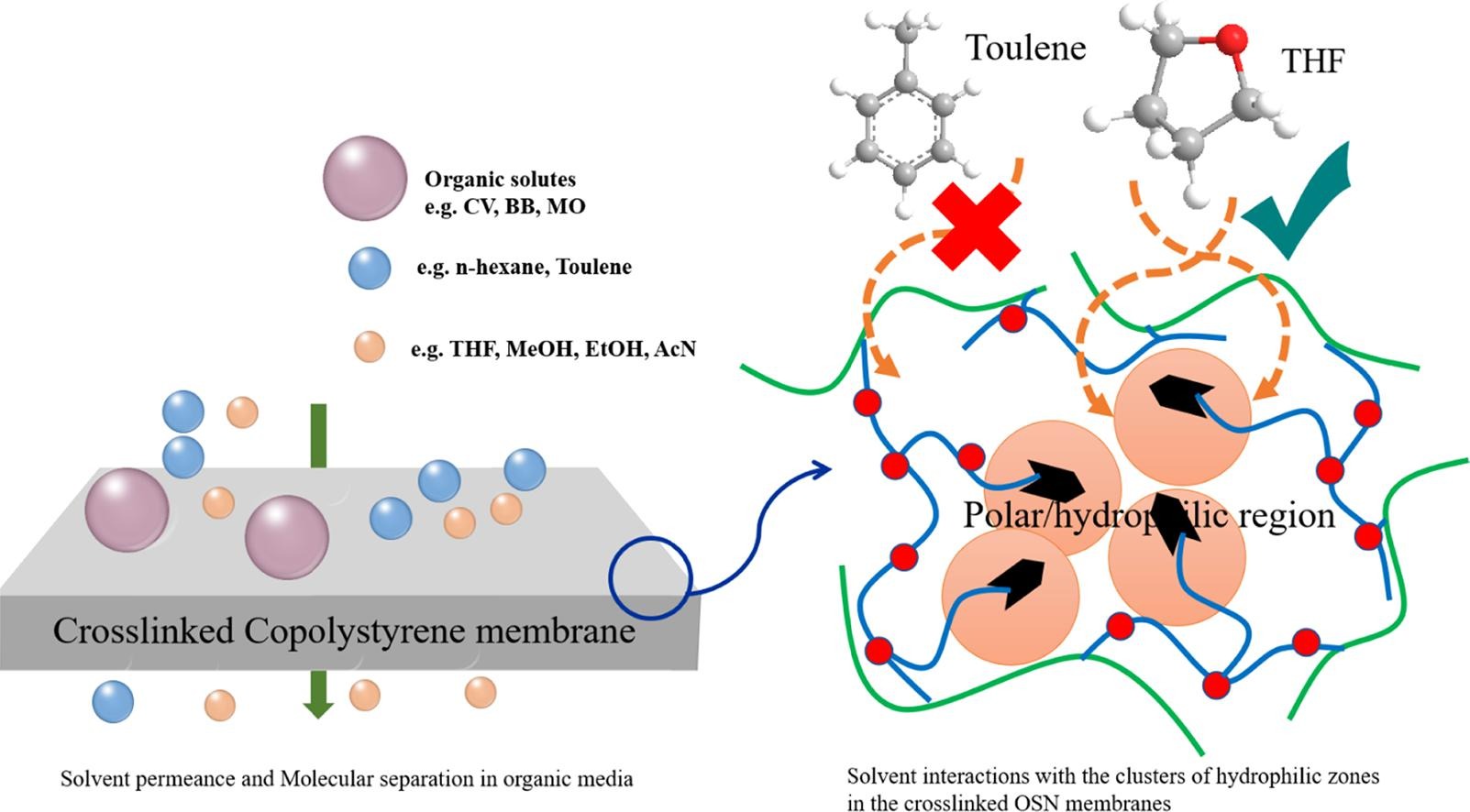
The research paper focuses on the construction of poly(styrene) membranes with flexible alkylcarboxylated and alkylsulfonated side chains for efficient separation of organic compounds. The interactions between the polymer chains and within the polymer matrix contribute to the membrane's flexibility. The results demonstrate that the membrane exhibits excellent stability in polar protonic solvents, mild polar aprotic solvents (such as THF, acetonitrile, and acetone), and nonpolar solvents. The ethanol flux reaches 4.16 L m−2 h−1 bar-1, and the membrane achieves a retention rate of over 96% for various small molecular solutes, including organic dye molecules, organic building blocks, and antibiotics. Furthermore, the membrane demonstrates selective separation of two molecules with a mass difference of 141 g mol-1. This research paper presents a promising strategy for enhancing the selective solvent permeation and separation of organic molecules in organic solvent nanofiltration (OSN) membranes by incorporating flexible hydrophilic/hydrophobic side chains into rigid polymers.
Full-text link: https://doi.org/10.1016/j.seppur.2021.119028
The research paper titled "Improving the water permeability and antifouling property of the nanofiltration membrane grafted with hyperbranched polyglycerol" is authored by Postdoctoral Researcher Xiaochan An as the first author, with Associate Professor Changkun Liu as the corresponding author. The first author affiliation and corresponding affiliation are both from Shenzhen University. This paper was published in the international journal Journal of Membrane Science, which has a recent impact factor of 10.53 and is listed as Tier 1 of the Journal Citation Reports (JCR) categorized by the Chinese Academy of Sciences.
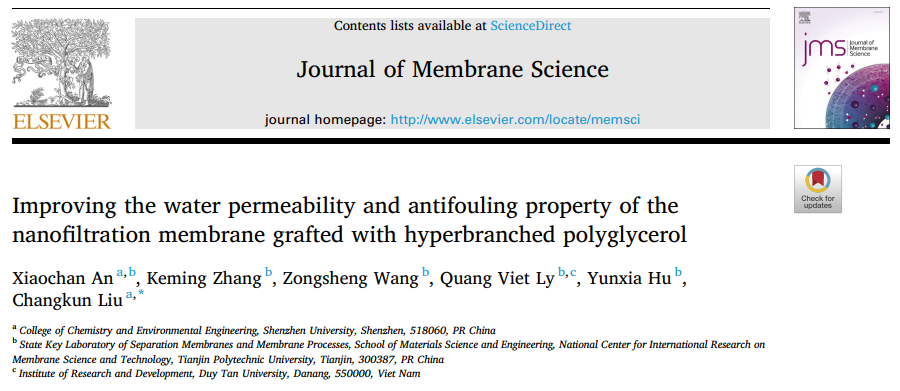
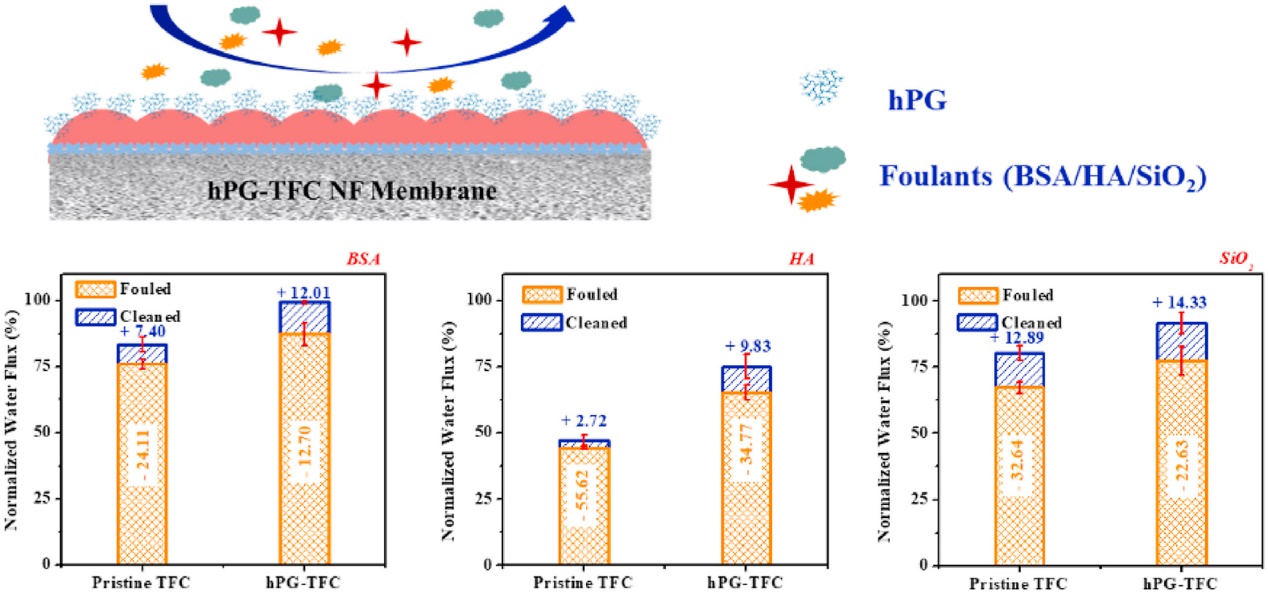
The research paper reports on the development of a high-performance thin-film composite nanofiltration (TFC-NF) membrane by grafting hyperbranched polyglycerol (hPG) with a unique three-dimensional spherical structure onto the polyamide (PA) layer. Experimental results show that the TFC-NF membrane exhibits a 30% increase in water flux compared to the unmodified membrane, without compromising the retention rate for Na2SO4 (97%). Additionally, using QCM-D (Quartz Crystal Microbalance with Dissipation) measurements to assess surface adsorption rates and model pollutant quantities, it is demonstrated that the membrane exhibits strong fouling resistance.
Full-text link: https://doi.org/10.1016/j.memsci.2020.118417
The research paper titled "Noncovalently Functionalized Sulfated Castor Oil-Graphene Oxide-Strengthened Polyetherimide Composite Membranes for Superior Separation of Organic Pollutants and Their Fouling Mitigation" is authored by Postdoctoral Researcher Palsamy Kanagaraj as the first author, with Associate Professor Changkun Liu as the corresponding author. The first author affiliation and corresponding affiliation are both from Shenzhen University. This paper was published in the international journal ACS Applied Materials & Interfaces, which has a recent impact factor of 10.383 and is listed as Tier 1 of the Journal Citation Reports (JCR) categorized by the Chinese Academy of Sciences.

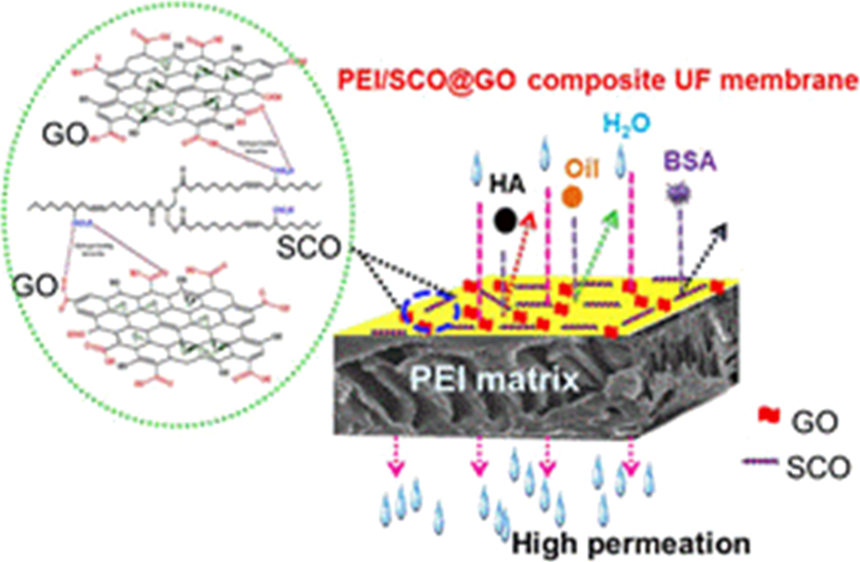
The research paper describes the preparation of a novel sulfated castor oil (SCO)-graphene oxide (GO) reinforced polyetherimide (PEI) membrane using a phase inversion method. This membrane is designed for the efficient separation of various organic pollutants and exhibits excellent long-term fouling resistance. The results show that the water flux of the PEI/SCO@GO membrane (410.6 L m-2 h-1) is approximately 50 times higher than that of the PEI membrane (50.7 L m-2 h-1) and about 6 times higher than that of the PEI/SCO membrane (64.5 L m-2 h-1). The PEI/SCO@GO membrane demonstrates outstanding retention rates (>99.0%) for water-in-oil emulsions and humic acid (HA) solutions, with high flux recovery rates (FRR) and strong fouling resistance. Therefore, the incorporation of SCO and GO into the PEI matrix transforms the highly hydrophobic PEI material into a suitable and ideal fouling-resistant membrane for the treatment of various organic pollutants in wastewater.
Full-text link: https://dx.doi.org/10.1021/acsami.0c07670
The research paper titled "Towards improved protein anti-fouling and anti-microbial properties of poly(vinylidene fluoride) membranes by blending with lactate salts-based polyurea as surface modifiers" is authored by Postdoctoral Researcher Palsamy Kanagaraj as the first author, with Associate Professor Changkun Liu as the corresponding author. The first author affiliation and corresponding affiliation are both from Shenzhen University. This paper was published in the international journal Journal of Colloid and Interface Science, which has a recent impact factor of 9.965 and is listed as Tier 1 of the Journal Citation Reports (JCR) categorized by the Chinese Academy of Sciences.
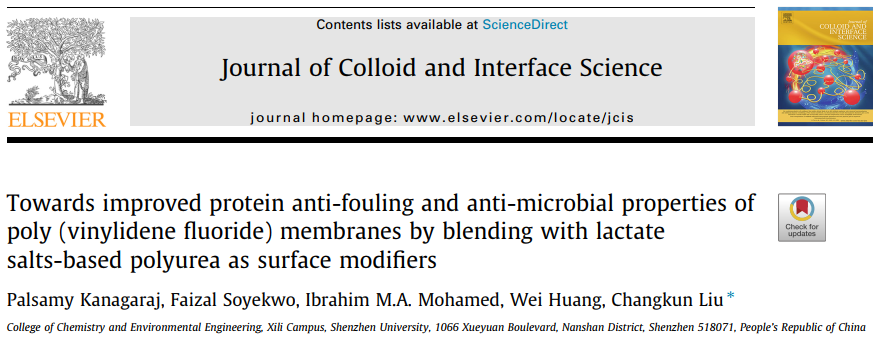
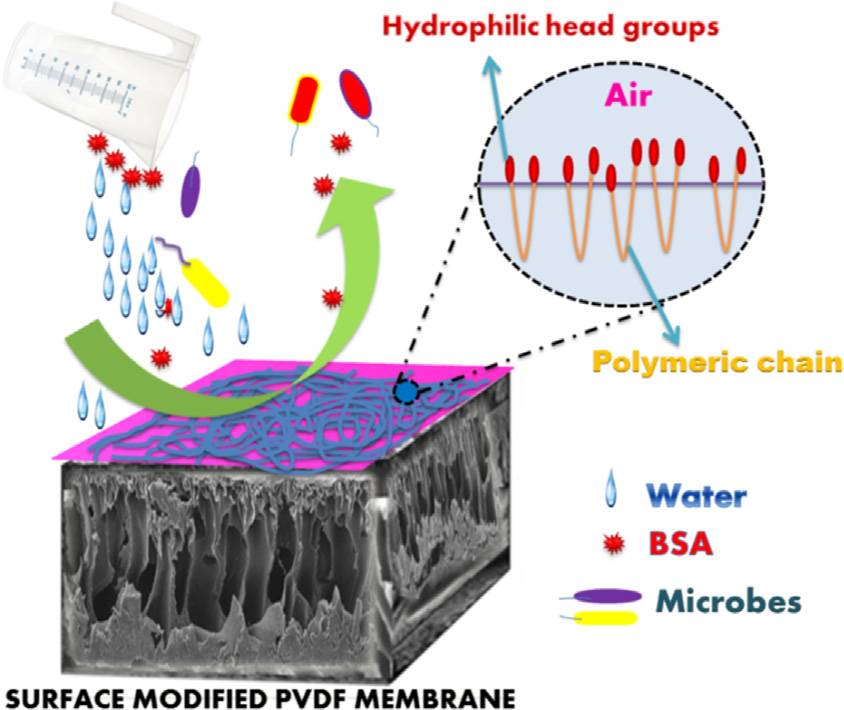
The research paper proposes the use of lactate salts-based polyurea as surface modifiers (SMs) to impart antimicrobial and protein-resistant properties to membranes, thereby extending their lifespan. The results indicate that the modified membranes exhibit good rejection and fouling resistance towards bovine serum albumin (BSA) molecules. Additionally, the water flux of the modified membrane (174.2 L m-2 h-1) is enhanced by 12 times compared to the unmodified membrane. After undergoing long-term operation for 200 days, the modified membrane maintains a water flux of over 90% of its initial value.
Full-text link: https://doi.org/10.1016/j.jcis.2020.02.026
